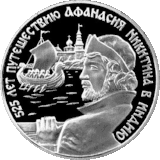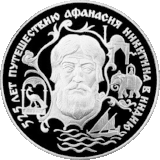Afanasy Nikitin
Afanasy Nikitin (Russian: Афана́сий Ники́тин; died 1472) was a Russian[1] merchant from Tver and one of the first Europeans (after Niccolò de' Conti) to travel to and document his visit to India. He described his trip in a narrative known as The Journey Beyond Three Seas (Russian: Хождение за три моря, Khozhdeniye za tri morya).
The voyage
In 1466, Nikitin left his hometown of Tver on a commercial trip to India. He travelled down the Volga River, and although he was attacked and robbed by Tatars near Astrakhan, he succeeded in reaching Derbent, where he joined Vasili Papin, the envoy of Ivan the Great to the shah of Shirvan. At Derbent, Nikitin vainly endeavoured to get means of returning to Russia; failing in this, he went on to Baku and later Persia proper by crossing the Caspian Sea.[2] He lived in Persia for one year. In the spring of 1469, Nikitin arrived at the city of Ormus and then, crossing the Arabian Sea, and making several prolonged stays along the way,[3] reached the sultanate of Bahmani, where he would live for three years. From what he tells us, he appears to have made his living by horse-dealing. During that time he visited the Hindu sanctuary of Perwattum, which he called "the Jerusalem of the Hindus".[4][2]
On his way back, Nikitin visited Muscat, the Arabian sultanate of Somalia and Trabzon, and in 1472 arrived at Feodosiya by crossing the Black Sea. On his way to Tver, Nikitin died not far from Smolensk in the autumn of that year.
During his trip, Nikitin studied the population of India, its social system, government, military (he witnessed war-games featuring war elephants), its economy, religion, lifestyles, and natural resources. The abundance and trustworthiness of Nikitin's factual material provide a valuable source of information about India at that time, and his remarks on the trade of Hormuz, Cambay, Calicut, Dabhol, Ceylon, Pegu and China; on royal progresses and other functions, both ecclesiastical and civil, at Bahmani, and on the wonders of the great fair at Perwattum—as well as his comparisons of things Russian and Indian—deserve special notice.[2]
Nikitin, Christianity, and Islam


After studying Nikitin's account, and especially his references to Islam (at the time much of India was ruled by Muslim sultans and there were considerable numbers of Muslim merchants living along the coast), particularly the prayers he transliterates from Arabic and Turkic into Cyrillic letters, Gail Lenhoff and Janet Martin speculated that Nikitin might have converted to Islam while in India.[5]
His loss of contact with Christianity and his life among Muslims (and apparent lapse from Christianity and conversion to Islam) bothered him and he mentions this several times in his account. Indeed, he begins his account calling it his "sinful voyage beyond three seas." He went on to explain that, while he continued to date events by Christian religious holidays and invoked the Mother of God and the saints ("the Holy Fathers"), he could not remember when Christian holidays were, so he could not celebrate Easter and other movable feast days or keep the Christian fasts (Lent, the St. Peters' Fast, the fast during Advent, etc.). Thus, he kept the fasts of the Muslims and broke fast when they did. He also wrote that at Bindar in the third year of his journey he "shed many tears for the Christian faith". Very near the end of his account, he wrote of his wish to return home and to the Christian faith: "I, Afanasy, a damned servant of Almighty God, Maker of heaven and earth, pondered over the Christian faith, the Baptism of Christ, the fasts established by the Holy Fathers, and the apostolic commandments, and I longed to go [back] to Rus!"[6]
Yakov Lurye, an editor of Nikitin's Journey, sees his conversion as doubtful, pointing out that a circumcised convert should be persecuted or even put to death in Rus', so if Nikitin had indeed become a Muslim, he would have avoided returning to his country, while in fact he died on his way back in Lithuania not far from the Muscovite border.
Nikitin in modern memory
In 1955, the local authorities of Tver erected a bronze monument to Afanasy Nikitin on the bank of the Volga River. The sculptor was Sergei Orlov. There is a folk legend that this statue was raised because Nikita Khrushchev, upon visiting India, told Prime Minister Jawaharlal Nehru that there was a statue of Nikitin in Russia when in fact there was not (Nehru had asked if the Russians had honored the first Russian to visit India). So as not to be proven a liar, Khrushchev phoned back to Russia demanding that a statue of Nikitin be built immediately, before Nehru's state visit to Russia. The statue was featured on a Russian postage stamp in 2005 commemorating the 75th Anniversary of the establishment of the Tver region (oblast).[7] Nikitin was also featured on a coin commemorating the 525th anniversary of his journey.
In 1958, the Russian state-owned Mosfilm Studio and Indian director Khwaja Ahmad Abbas' "Naya Sansar International" production house co-produced a film entitled The Journey Beyond Three Seas with Oleg Strizhenov cast as Nikitin.
In 2000, a black obelisk was erected in Nikitin's honor at Revdanda, 120 km south of Mumbai, the probable location where he first set foot in India.
In 2006, the Indian organization Adventures & Explorers, with the support of the Embassy of India in Moscow and the Tver Regional Administration sponsored a Nikitin Expedition, in which 14 travelers set out from Tver to retrace Nikitin's journey through Russia, the Middle East, and Central Asia to India.[8] The expedition lasted from 12 November 2006 to 16 January 2007. The Indian newspaper The Hindu filed several reports on the expedition's progress.[9] After reaching India, two members of the expedition set out in March 2007 from Mumbai in SUVs to retrace Nikitin's travels around India itself.[10]
The Afanasy Nikitin Seamount in the Indian Ocean is named in his honor.
In culture
Rock band Aquarium composed a song "Afanasy Nikitin Boogie". Power metal band Epidemia composed a song "Хождение за три моря" (Khozhdeniye za tri morya – "Walking the Three Seas") about Nikitin's writings. A brand of Tver beer, "Afanasy", is named after Afanasy Nikitin.[11]
See also
- Daniel Kievsky
- Chronology of European exploration of Asia
- Niccolò de' Conti (1385–1469) - another European who traveled to India a few decades before Nikitin
- some marginal notes on india:sergei d serebriany
References
- M. J. Maxwell. Afanasii Nikitin: An Orthodox Russian's Spiritual Voyage in the Dar al-Islam, 1468-1475. Journal of World History. Vol. 17, No. 3 (Sep., 2006), p. 243; D. P. M. Weerakkody. Sri Lanka, p. 1126; A. A. Postnikov. Nikitin, Afanasii (fl. Fifteenth Century), pp. 859-861; K. Karttunen, Indian Subcontinent, Pre-1500, p. 615 // J. Speake (ed.) Literature of Travel and Exploration: An Encyclopedia. Volume 1, A to F. Routledge. 2013; C. H. Whittaker. Russia engages the world, 1453-1825. Harvard University Press, 2003. P. 141; R. M. Eaton. A Social History of the Deccan, 1300-1761: Eight Indian Lives, Volume 1. Cambridge University Press, 2005. P. 72; The new encyclopaedia Britannica: in 32 vol. Macropaedia, India - Ireland, Volume 21. 1992. P. 183; Afanasy Nikitin's Voyage Beyond Three Seas: 1466-1472. Raduga, 1985. P. 65;J. Burbank, M. Von Hagen, A. V. Remnev. Russian Empire: Space, People, Power, 1700-1930. Indiana University Press. 2007. P. 240; A. V. Riasanovsky. Afanasii Nikitin's Journal. Journal of the American Oriental Society, Volume 81. 1961. P. 126; J. R. Millar. Encyclopedia of Russian History, Volume 1. Macmillan Reference, 2003. P. 93
-

- Chisholm 1911.
- Major 1857, p. lxxviii.
- Gail Lenhoffand Janet Martin "The Commercial and Cultural Context of Afanasij Nikitin's Journey Beyond Three Seas." Jahrbücher für Geschichte Osteuropas 37, No. 3 (1989):321 - 344; See also Janet Martin, "Muscovite Travelling Merchants: The Trade with the Muslim East (Fifteenth and Sixteenth Centuries)." Central Asian Studies 4, No. 3 (1985):21 - 38.
- For a translation of Nikitin's account, see Major 1857. See also the online English translation at: "History". Archived from the original on 2007-07-12. Retrieved 2007-07-07.
- See Stamp News International at: http://www.stampnews.com/stamps/stamps_2005/stamp_1173967252_581033.html Archived 2007-09-28 at the Wayback Machine
- See the online press report from the Embassy of India in Moscow at: http://www.indianembassy.ru/en/en_05_04_t0311_2006.html%5B%5D
- See the online versions of the articles at: http://www.hindu.com/2006/12/10/stories/2006121000542000.htm and http://www.hindu.com/2006/11/26/stories/2006112602291000.htm
- See the online version of the article at: http://www.telegraphindia.com/1070322/asp/nation/story_7550104.asp
- Торговая марка пива "Афанасий"
Sources
- Major, Richard (1857). India in the Fifteenth Century : Being a Collection of Narratives of Voyages to India in the Century Preceding the Portuguese Discovery of the Cape of Good Hope, from Latin, Persian, Russian, and Italian Sources. Cambridge: Cambridge University Press. ISBN 978-1-108-00816-7.CS1 maint: ref=harv (link)
- M. J. Maxwell. Afanasii Nikitin: An Orthodox Russian's Spiritual Voyage in the Dar al-Islam, 1468-1475. Journal of World History. Vol. 17, No. 3 (Sep., 2006)
- J. Speake (ed.) Literature of Travel and Exploration: An Encyclopedia. Volume 1, A to F. Routledge. 2013
- C. H. Whittaker. Russia engages the world, 1453-1825. Harvard University Press, 2003. P. 141
- The new Encyclopædia Britannica: in 32 vol. Macropaedia, India - Ireland, Volume 21. 1992. P. 183
- Afanasy Nikitin's Voyage Beyond Three Seas: 1466-1472. Raduga, 1985
- J. Burbank, M. Von Hagen, A. V. Remnev. Russian Empire: Space, People, Power, 1700-1930. Indiana University Press. 2007. P. 240
- A. V. Riasanovsky. Afanasii Nikitin's Journal. Journal of the American Oriental Society, Volume 81. 1961.
- J. R. Millar. Encyclopedia of Russian History, Volume 1. Macmillan Reference, 2003. P. 93
| Wikimedia Commons has media related to Afanasy Nikitin. |